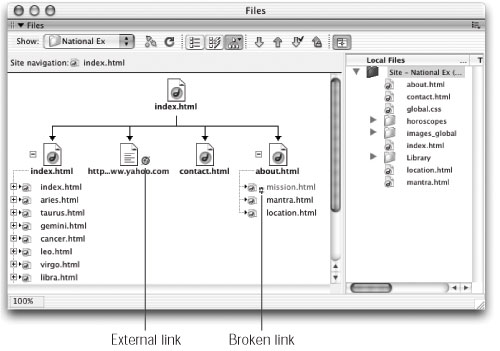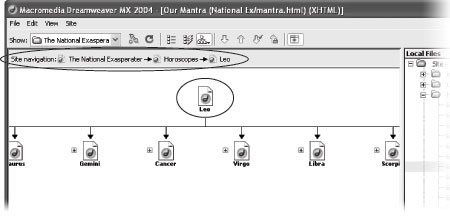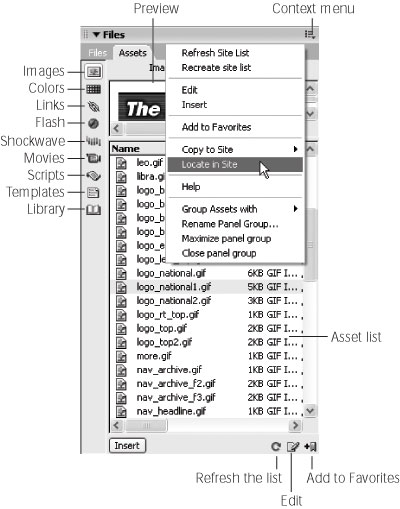14.2 Viewing a Site Map
While the Files panel's list of files and folders is a great aid in managing those files, it
doesn't give you a picture of how your site's Web pages are linked together. You can
see that the index.html file in the root folder is the site's home page, for instance, but
you can't see how it relates to the other pages in the site. In other words, you can't tell
which pages link to or from it. To see those relationships, you need Dreamweaver's
Site Site Map view. Site Map view.
The Site Map is a visual guide to the links in a site (see Figure 14-10). An icon representing
the home page appears at the top of the map, and arrows connect the home
page to icons representing each of the links it contains. As shown in Figure 14-10,
special icons clearly mark external, broken, and email links. The best way to view
them is by expanding the Files panel (Section 14.1.4), which spreads the links out into
easy-to-read columns. In regular collapsed view, all the links in the map are put into
a single column, so you need to scroll down to see the each one. Furthermore, the Site Map does more than just provide a visual overview; it also gives you an easy way to rename files and even retitle Web pages.

14.2.1 Setting Up Site Map View
To view a Site Map, you'll first need to do a little preparation:
Choose Site Manage Sites (or choose Manage Sites from the Site menu in the
Files panel). Manage Sites (or choose Manage Sites from the Site menu in the
Files panel).
The Manage Sites window appears, listing all of your sites. Click a site name and click Edit (or just double-click the site name).
The Site Definition window opens. If you're defining this site for the first time, you can also follow steps 3-9 in Section 14.1.1 now. In the Category list, choose Site Map Layout.
You see the dialog box shown in Figure 14-11. Click the folder icon next to the Home Page field. Navigate to the home page file
in the site's root folder.
Click Select (Windows) or Open (Mac) to set this page as the home page.

Remember that your home page must be in the root folder. Technically, you can
choose a file that's buried several folders deep in your site folder, but don't do
it梪nless, of course, you really want to tell people to visit your company's home
page at www.mycompany.com/about_us/about_me/my_dog/ralphie.html. By specifying
a home page in the outer level of your root folder, you can assure that the
home page will be at www.mycompany.com.
Set any other Site Map preferences you wish.
The Number of Columns field determines how many links can be displayed in a
single row of the Site Map. For instance, if you set the number of columns to five,
but the home page has ten links on it, the Site Map only has enough columns for the
first five links; the remaining five icons get bumped down to a second row directly
below the first. Displaying more than one row of links from the home page can be
confusing, so it's best to use a number of columns that's at least equal to the number
of links on the home page. Dreamweaver's default value of 200 is just fine. The Column Width represents the width, in pixels, of each column. As you can
see in the box in Section 14.2.2.2, file names and page titles may not fully appear if the
column width is too small. Again, stick with Dreamweaver's default value of 125. NOTE
The column width and number settings have no effect except when the Files panel is in expanded
view (Figure 14-7).
Using the Icon Labels buttons, choose whether you want the Site Map to display
the file name (index.html) or page title ("Welcome to Cosmopolitan Farmer")
next to each page's icon. Shift+Ctrl+T (Shift- -T) toggles between the two views when viewing the Site Map. -T) toggles between the two views when viewing the Site Map. Once you've got your Site Map on display, you can hide certain files for the sake
of clutter reduction by marking them as hidden. To make sure they stay hidden,
leave Display files marked as hidden turned off. You can always make the hidden
files reappear using the steps described in Section 14.2.2.3. The Display dependent files option will make GIF, JPEG, CSS, Flash, and all other
non-HTML files show up in the Site Map. Since this can make the site map a confusing
jumble of files, it's best to leave this option turned off. Click OK.
You return to the Files panel.
14.2.2 Viewing and Customizing Site Map View
Once you've set up Site Map view as described above, you can see it by choosing Map
View from the Files panel's unlabeled View menu (identified in Figure 14-6). Because
the Files panel is narrow, click the Expand/Collapse View button (also shown in Figure 14-6) to maximize the map area.
When you first view the Site Map, only the first two levels梩he home page and all of
the pages linked from it梐ppear. A + symbol next to a page indicates that there are
additional links on that page; clicking the + expands the list of links on that page. If
those pages in turn have links, additional + symbols appear. You can continue to follow
the links by expanding each page, but viewing too many levels at once can bring
a confusing complication; see the box in Section 14.2.2.2 for advice.
As in the Site file list, you can open a page by double-clicking its icon in the Site Map.
In fact, if the Files panel is expanded (so that both the Site Map and Local Site file listings appear), selecting a page in the Site Map highlights the corresponding page
in the File list, and vice versa.
14.2.2.1 Identifying pages in the Site Map
The Site Map view starts out displaying the file name of each Web page, which can
be less than informative. If you've structured your site (as recommended in Section 14.1) so that the main page for each section of the site is stored in a different folder
and is named index.html, the Site Map will be an unhelpful sea of index.html labels (see Figure 14-10).
A better approach: use each page's title as the icon label. You can do this either when
you first set up the site, as described in Section 14.1.1, or choose View Show Page Titles
from the Files panel's contextual menu (see Figure 14-13). Repeat the same command
to see the file names again. The keyboard shortcut is a fast way to toggle between the
two views: Shift+ Ctrl+T (Shift- Show Page Titles
from the Files panel's contextual menu (see Figure 14-13). Repeat the same command
to see the file names again. The keyboard shortcut is a fast way to toggle between the
two views: Shift+ Ctrl+T (Shift- -T). -T).
NOTE
In Windows, if the Files panel is expanded, you'll see a menu across the top of the panel, as pictured
in Figure 14-12. This menu offers the same options as the contextual menu visible in the collapsed panel, shown in Figure 14-10.
14.2.2.2 Viewing just part of a Web site
When viewing large Web sites, you might find the Site Map awkward. Perhaps you're
working on just a single section, and don't want to be bothered with the extraneous
details of the rest of the site. No problem: you can isolate a particular page when viewing the Site Map. Click a page in the Site Map and choose View View as Root from the Files panel's contextual menu (Figure 14-13). Alternatively, you can right-click
Control-Click) the page and select View as Root from the menu that appears. The
page you selected appears as the top-level page in the Site Map (see Figure 14-12). View as Root from the Files panel's contextual menu (Figure 14-13). Alternatively, you can right-click
Control-Click) the page and select View as Root from the menu that appears. The
page you selected appears as the top-level page in the Site Map (see Figure 14-12).
|
The Site Map clearly displays links between pages, but if you're not careful, you may end up chasing your tail. Very
often, Web pages link back and
forth to each other. For example,
the home page may link to a page
in the site that, in turn, links back
to the home page.
In this example illustrated here,
the horoscopes main page
("Horoscopes") has a link to
the home page ("The National
Exasperater"), which links to the
horoscopes page, which links back
to the home page, which links to the horoscopes page梐nd
so on. All four of the pages indicated by arrows are, in fact, As shown here, the Site Map
shows the horoscope page as a
link from the home page. When
you then click the + to expand
the advertising page, you see a
duplicate icon for the home page
(whose original icon appears at
the top of the Site Map). When
you click the + sign next to the
home page icon under the horoscopes
page, you don't get a new
level of site links, even though the
Site Map displays it that way. What you've done is "re-expand"
the home page to display more duplicate icons.

|

14.2.2.3 Hiding extraneous links
Like some people you may know, the Site Map loves detail; it includes all links from
your pages, including external links and email links. At times, this may be a bit more
information than you need. Suppose you provide 200 email addresses on a single
page; you probably don't need to see all of those listed in the Site Map.
Fortunately, Dreamweaver lets you hide any links you wish. All you have to do is select
the files you want to hide (Shift-click them, or drag across a group of them) and then
choose View Show/Hide Link from the Files panel's contextual menu, or right-click
(Control-click) the selected files and choose Show/Hide link from the menu that appears;
Dreamweaver makes them disappear. Show/Hide Link from the Files panel's contextual menu, or right-click
(Control-click) the selected files and choose Show/Hide link from the menu that appears;
Dreamweaver makes them disappear.
To show hidden files again, choose View Show Files Marked as Hidden from the
Files panel's contextual menu. Dreamweaver makes all hidden files appear with their
names italicized, indicating that you've marked them as hidden. You can turn off a file's "hidden" status by selecting it and choosing View Show Files Marked as Hidden from the
Files panel's contextual menu. Dreamweaver makes all hidden files appear with their
names italicized, indicating that you've marked them as hidden. You can turn off a file's "hidden" status by selecting it and choosing View Show/Hide Link, or rightclicking
(Control-clicking) the file and choosing Show/Hide link. Show/Hide Link, or rightclicking
(Control-clicking) the file and choosing Show/Hide link.
|
After perfecting your Site Map, you may want to make a
hard copy of it. While Dreamweaver won't print the Site
Map (why, Macromedia, why?), you can save it as a graphic
and then print it.
Here's the ritual: In Site Map view, choose File Save Site
Map from the Files panel's contextual menu (for Windows,
if the panel is expanded, you can select Save Site Map from
the File menu at the top of the window). Name the graphic
and save it onto your computer. (Windows users can also
choose a file format for the graphic桺NG or BMP. On the
Mac, Dreamweaver saves the map as a PICT file.) Save Site
Map from the Files panel's contextual menu (for Windows,
if the panel is expanded, you can select Save Site Map from
the File menu at the top of the window). Name the graphic
and save it onto your computer. (Windows users can also
choose a file format for the graphic桺NG or BMP. On the
Mac, Dreamweaver saves the map as a PICT file.)
To print the resulting graphics file, double-click it to open it
in, say, Image Viewer (Windows) or Preview (Macintosh).
You can print it from there.
|
14.2.3 Renaming Pages in the Site Map
You can rename files in Site Map view, which works similarly to renaming them in the
File List view. However, only the Site Map lets you easily change the titles of your site's
Web pages. In fact, this is one of the best features of the Site Map. While displaying
the page titles, you can quickly scan your site for missing or incorrect page titles and
fix them in just a few steps.
You rename a file in the Site Map just as you do in the Files panel; the steps appear
in Section 14.1.5.4. In this case, just be sure you're looking at the right kind of data梕ither
page titles or file names梑efore you begin. Press Shift+ Ctrl+T (Shift- -T) to switch
back and forth when viewing the Site Map. -T) to switch
back and forth when viewing the Site Map.
When you're finished, Dreamweaver rewrites the title in the HTML of the page. The
new title also appears next to the page icon. Or, if you've changed the name of the file,
Dreamweaver's Update Files dialog box appears, letting you fix any links that point
to the newly named file.

|

Show/Hide Link from the Files panel's contextual menu, or right-click
(Control-click) the selected files and choose Show/Hide link from the menu that appears;
Dreamweaver makes them disappear.
Show Files Marked as Hidden from the
Files panel's contextual menu. Dreamweaver makes all hidden files appear with their
names italicized, indicating that you've marked them as hidden. You can turn off a file's "hidden" status by selecting it and choosing View
Show/Hide Link, or rightclicking
(Control-clicking) the file and choosing Show/Hide link.
![]() -T) to switch
back and forth when viewing the Site Map.
-T) to switch
back and forth when viewing the Site Map.